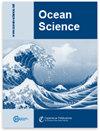Equatorial wave diagnosis for the Atlantic Niño in 2019 with an ocean reanalysis
IF 3.3
3区 地球科学
Q2 METEOROLOGY & ATMOSPHERIC SCIENCES
引用次数: 0
Abstract
Abstract. The propagation of equatorial waves is essential for the onset of Atlantic Niño, but diagnosing waves with ocean reanalysis or in situ data remains a challenge. This study uses an ocean reanalysis to diagnose the wave energy transfer route during the 2019 event. The climatological values and the anomaly in 2019 at each grid point are decomposed into the first four baroclinic modes based on their local density profiles. The decomposed geopotential can well reproduce the displacement of the thermocline during the event. Wave energy flux is calculated by means of a group-velocity-based scheme. In addition to detecting wind-forced Kelvin waves and reflected Rossby waves, the wave energy flux reveals another possible energy transfer route along the western boundary, where some off-equatorial wave energy can excite coastally trapped Kelvin waves and transfer back to the equatorial Atlantic. Five transects are selected, across which the passing wave energy fluxes in 2019 are integrated. The results suggest that the Kelvin waves in the third and fourth mode are locally forced, while the wave energy in the second mode is more likely from the off-equatorial region. Therefore, in the autumn of 2019, the second-mode Kelvin waves can deepen the thermocline ahead of other modes from September, serving to precondition the Niño event.利用海洋再分析对 2019 年大西洋厄尔尼诺现象进行赤道波诊断
摘要。赤道波的传播对大西洋Niño的发生至关重要,但用海洋再分析或现场数据诊断海浪仍然是一个挑战。这项研究使用海洋再分析来诊断2019年事件期间的波浪能量传递路线。根据各格点的局地密度分布,将各格点2019年的气候值和异常分解为前4个斜压模态。分解后的地势可以很好地再现事件中温跃层的位移。波浪能量通量的计算采用基于群速度的格式。除了探测风强迫开尔文波和反射的罗斯比波之外,波浪能量通量揭示了沿西部边界的另一种可能的能量传递路线,在那里一些离赤道的波浪能量可以激发沿海捕获的开尔文波并转移回赤道大西洋。选取5个断面,对2019年通过的波能通量进行积分。结果表明,第三和第四模态的开尔文波是局部强迫的,而第二模态的波能量更可能来自赤道外区域。因此,2019年秋季,从9月开始,第二模开尔文波可以先于其他模态加深温跃层,为Niño事件提供了先决条件。
本文章由计算机程序翻译,如有差异,请以英文原文为准。
求助全文
约1分钟内获得全文
求助全文
来源期刊

Ocean Science
地学-海洋学
CiteScore
5.90
自引率
6.20%
发文量
78
审稿时长
6-12 weeks
期刊介绍:
Ocean Science (OS) is a not-for-profit international open-access scientific journal dedicated to the publication and discussion of research articles, short communications, and review papers on all aspects of ocean science: experimental, theoretical, and laboratory. The primary objective is to publish a very high-quality scientific journal with free Internet-based access for researchers and other interested people throughout the world.
Electronic submission of articles is used to keep publication costs to a minimum. The costs will be covered by a moderate per-page charge paid by the authors. The peer-review process also makes use of the Internet. It includes an 8-week online discussion period with the original submitted manuscript and all comments. If accepted, the final revised paper will be published online.
Ocean Science covers the following fields: ocean physics (i.e. ocean structure, circulation, tides, and internal waves); ocean chemistry; biological oceanography; air–sea interactions; ocean models – physical, chemical, biological, and biochemical; coastal and shelf edge processes; paleooceanography.
 求助内容:
求助内容: 应助结果提醒方式:
应助结果提醒方式:


